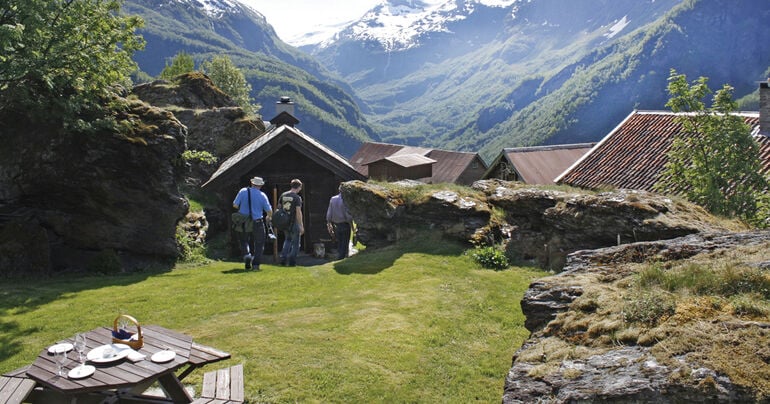Start 14-Day Trial Subscription
*No credit card required

In Search of Norway's Brewing Traditions
Such was the importance of beer in the majestic fjords of olden Norway, the idea of spilling one’s own homebrew was appalling, even while traversing the country’s typically vertical terrain. Beer played such a significant role among Norwegians that ailing people used to make sure homemade malt was ready for brewing when sensing oncoming death. One would not want to serve unworthy beer at one’s own funeral, right?
Picking himself up after a bad fall along a rocky hillside, a beer-carrying homebrewer looks at the dark stains on his clothing. His first worry is obvious. ‘I hope it’s blood,’ he says. – from a 19th Century Norwegian folk tale
Photo above: High above the Flåm Valley, the Holo Gardstun’s house beer is part of the attraction.
But more importantly there was beer to be shared at Christmas. Families throughout the country made beer for the holiday season, a potent, malty-sweet brew that was shared with neighbors as well as relatives, made through age-old methods passed from generation to generation.
These fascinating traditions, alongside many others, are thoroughly documented, region per region and process by process, in author Odd Nordland’s study of brewing in Norway published in 1969.

But not many in today’s ever expanding beer universe are talking about these brews. Even Norway’s two leading craft breweries, Haandbryggeriet and Nøgne Ø (whose name is a phrase taken from a popular 19th Century Norwegian poem), have their eyes on present trends. They don’t have anything in their extensive portfolios, apart from a few label references, that acknowledge these somewhat forlorn farmland homebrews.
Norway’s unique traditions remain in the hands of longtime smaller scale practitioners who quietly sustain the age-old methodologies, not letting them fade away. A trip to Norway in search of these brewers turned out to be well worth the effort.
Stage I
The Exploration Begins
Eating an entire eyeball will not be the most memorable part of your brewery visit.
A dozen sheep heads on spikes are turning around an evil-looking contraption, submitted to infernal torch-lit blasts every ten seconds or so. This is the main livelihood of Ivar Løne and his family. They have the only farm in Norway to be licensed to prepare
smalahove, sheep head smoked by alder wood and served at their reservations-only restaurant by a lake which bears the family surname.
Løne is also a proud traditional brewer. In the Vossevangen area on the southern coast of Norway near Bergen, his family is the only brewery to use ancestral firing vessels, methods and ingredients, concocting a true Vossabrygg brew of the Norwegian past. Over an open wood fire, he uses a copper cauldron with the capacity of two and a half barrels and a juniper branch infusion for all the water used in the brewing process. For fermentation he uses kveik, a yeast strain of unique character sustained on a reticulated wooden ring for human generations. It’s all here at the Smalahovetunet, Mr. Løne’s restaurant. And the end result is actually delicious, a beer with mild caramel tones and spicy orange peel aromas courtesy of the yeast. It’s a clean brew, an amazing feat considering his fermenters are two plastic containers which look like garbage bins.
To get your tastebuds on some of the house beer, you have to make reservations for a meal of smalahove, an experience which is not for the faint of heart, to say the least. The sight of the half sheep’s head, tongue and all, peering emptily at you on the plate is enough to make you doubt your temerity. And then Mr. Løne explains that you have to eat the eye first, otherwise its texture will become less interesting with cooling. He proceeds to cut around and dislodge the entire eyeball, sticking it on a fork and handing it over to you. And he’s not joking. Want your taste buds to learn more about Vossabrygg, or traditional brew from the Voss area now? Close your eyes and…
Turns out there are other ways to learn about it. But you need to get invited into private homes.
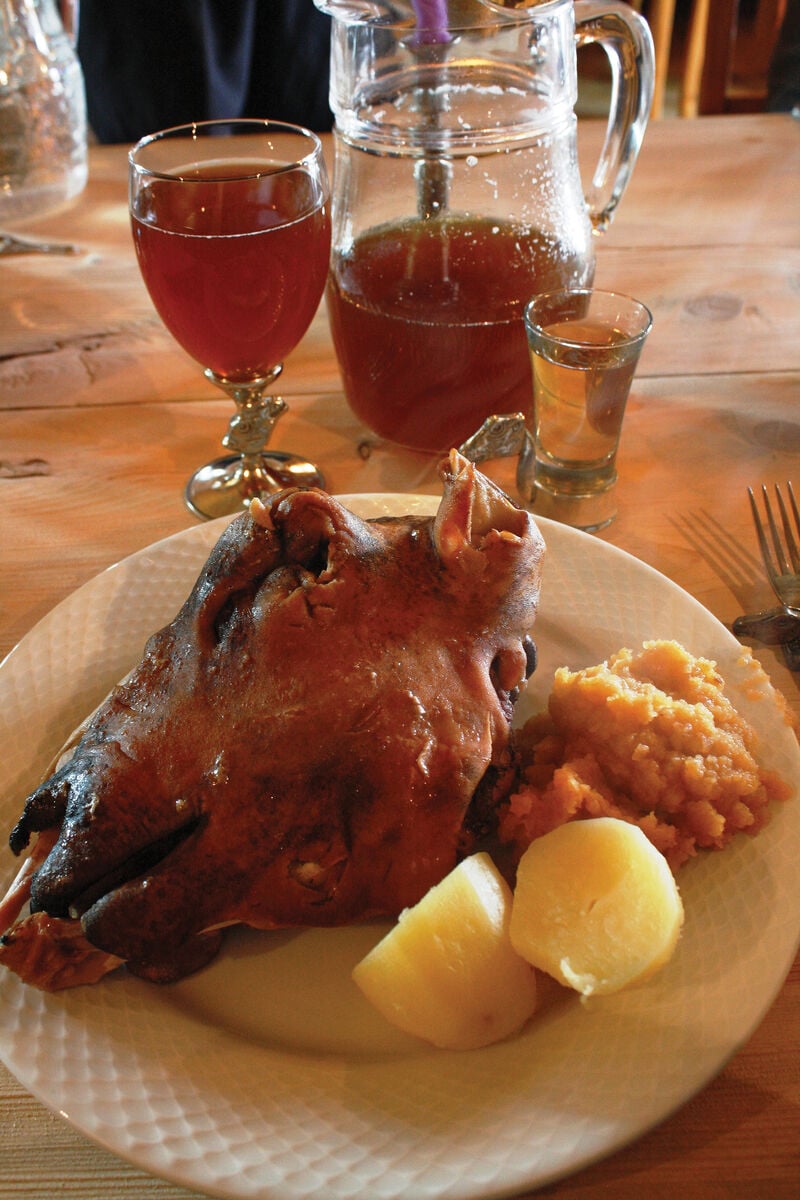
Is that smalahove actually smiling?
Stage II
Learning to Brew Norwegian Style
Martin the Guest Brewer: ‘Why do we start mashing at midnight?’ Traditional Norwegian Brewer: ‘So we can get some sleep.’
Due to painstaking research to find hidden keepers of Norway’s brewing past – research done conjointly with Norwegian beer blogger Lars Marius Garshol – a few traditional homebrewers actually invited us over for chats, meals, tastings, and even a 24-hour brewing session. The latter offer came from a man in Bulken, a hamlet close to Voss. Sigmund Gjernes’s pride in preserving his region’s brewing heritage was palpable throughout the many hours of conversation, eating and brewing together at his home. Thanks to his generosity, the secrets of Voss beer can be unveiled.
So what makes his Vossabrygg, or Vossaøl, so distinctive? To begin, all water used in the brewing process is heated with juniper tips. Not the berries though, as they supposedly impart unwanted bitterness and astringency. This juniper infusion is used for the mash and also to clean the massive, three-barrel copper cauldron. Brewers in these parts claim that juniper is anti-bacterial. Juniper branches are also used as a false bottom in the rudimentary mash tun.
The delicate caramel flavors don’t come from specialty malts, as only pilsner-type malts are used. Gjernes mashes for six hours, overnight, and then boils for four hours, essentially evaporating half the liquid from his 18th Century kettle. The color turns from golden to deep amber in the process, helped by the pale brown water tainted by the long juniper infusion. The wooden fire roaring under the kettle obviously contributes to this direct caramelization as well.
Like other Voss brewers, Gjernes uses the kveik yeast, which on some farms allows fermentation to take place at a head-turning 110 degrees. “The yeast paddle was handed over from father to eldest son in the manner of a royal scepter, for a passing of power of sorts,” said Gjernes. “A bit like I am doing now with my son, Yngve.”
Hops used to be grown on farms in Norway, but the indigenous varieties were eventually replaced by “over the counter” pharmacy hops, or even imported noble cultivars. Their main use has been to balance the residual sugars of the beer. Our later tasting of another local traditional homebrew from Vossevangen corroborates that approach. These rich glasses of western Norway’s time-honored libations are much more revealing than one can ever imagine through Nordland’s rather dry observations.
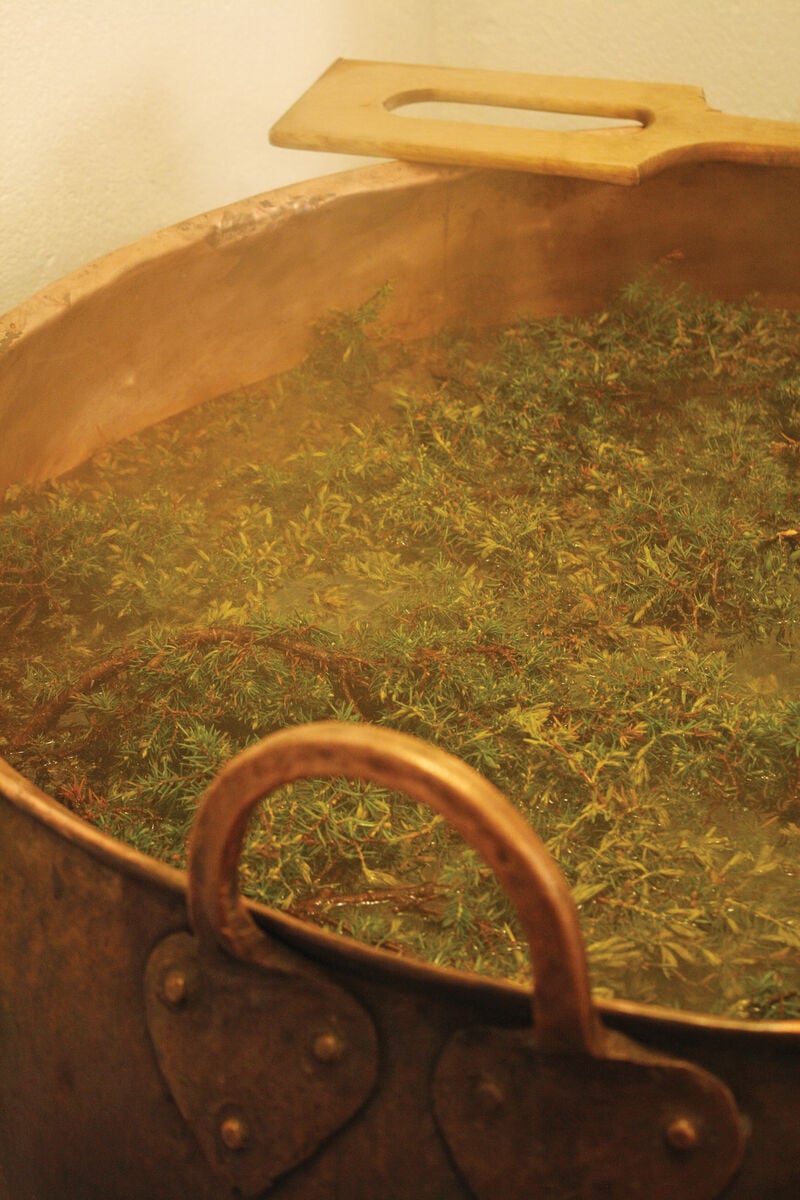
A juniper infusion precedes the mash in a Vossaøl recipe.
Stage III
Avoiding the flatline
Klostergården is, for now, the only licensed brewery in the world to brew and bottle a Stjørdalsøl
As if the Vossabrygg reality wasn’t spellbinding enough, there is another region of Norway where brewing traditions have been on the verge of flatlining. But home maltsters this time, and homebrewers of course, have been joining efforts to help Stjørdalsøl, sometimes called Maltøl, stay healthy.
In a small town midway up Norway’s coast called Skatval, Roar Sandodden has built himself a shed-size malting house according to the traditions of the Stjørdal region. Apart from being a laborsome process, it is one where he is able to inject the lifeblood of his barley malt: the direct smoke of alder wood. He then delivers all 120 kilos of his aromatic production across the river to Klostergården brewery, on the island of Tautra. Sandodden’s teamwork with Jørn Andersen of this tiny microbrewery has, for now, produced the only commercially-bottled Stjørdalsøl currently made, called Alstadberger. But this may change soon. No less than 40 small malthouses similar to Sandodden’s exist in the Stjørdal region. And the interest in alderwood-smoked Stjørdalsøl is far from dwindling.
Case in point, not far away in the town of Hegra, an older man by the name of Morten Granas has been malting his own grain and brewing his own farmhouse beer for many years. He has just recently applied to obtain a permit to sell his time-travel brew at area fairs. When we visited, he was even in the planning stages of designing a label for his plastic bottles to replace the 7-Up logo that adorned the recyclable bottle we received.
Showcasing the enormous variety in Stjørdalsøl, his brew stands tall and unique next to the more refined Klostergården interpretation. Powerfully earthy and smoky, it challenges the modern taster with rusticity, but also prevalent fruitiness and drinkability. Needless to say, the world of Stjørdalsøl cannot be summarized in neat, BJCP-like guidelines.
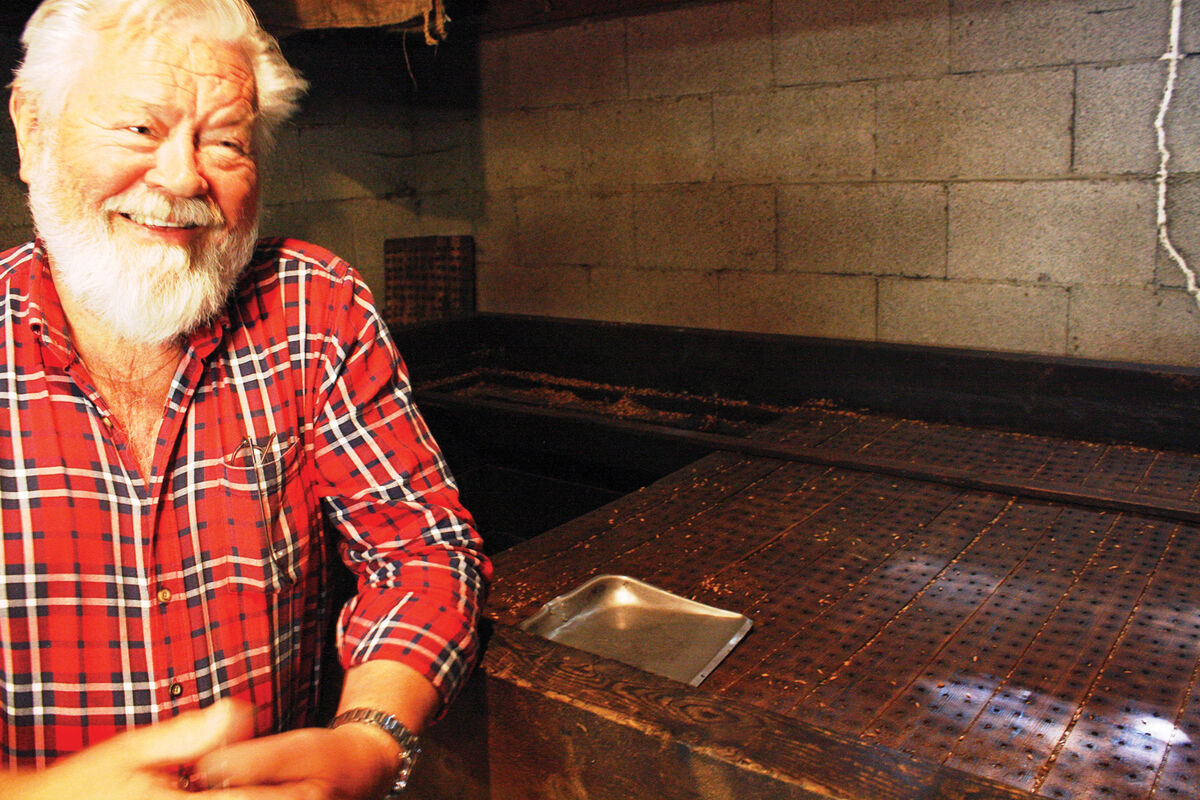
Morten Granas starts his homebrew with home-kilned malt.
Stage IV
A Spiritual Retreat
And now for a brew under 2 percent ABV…
In the center of Norway, buried deep in a bucolic alpine valley west of Oppdal, a lone stunning farm sits at the edge of a 60,000-acre spread. If the active Storli Gard sheep farm, where guests are also invited to enjoy hiking and spiritual renewal, seems far removed from modern civilization, the beer is even more so. Harald Storli does everything by hand. He doesn’t just malt his own grain, he takes away all germ shoots by hand before smoking his malt with alder wood in a roughshod shed behind the main farm building.
As if this weren’t already a trip to past centuries, he then foregoes boiling. He takes only the first and last runnings from the mash to boil in a small quantity of pharmacy hops before throwing everything into a wooden fermenter. The end result, a mere couple of days later, is extremely smoky. In terms of aromatic intensity, think of Aecht Schlenkerla, the rauchbier from Brauerei Hellter-Trum. But it is also quite fruity and earthy, with a few juniper twig notes. The mouthfeel, like all aforementioned traditional Norwegian beers, is silky sweet and nearly completely flat.
So what does he call his beer? Simply Maltøl, a generic name which refers to the fact that the beer is made from homemade malt. Maybe his daughter-in-law Wenche, whom he has taught to brew this old family recipe, will think of a catchier way to name this brew when she officially takes over brewing duties. For now, this beer will most likely survive another generation without any effort at commercialization beyond serving it to guests at Storli farm.
Most brewers in Norway simply don’t care to make their traditions known. Many don’t think the beer their families have been brewing for generations is that special; it’s a tradition that makes their Christmas festivities all the more meaningful. Often, their beers don’t have a specific name. Some just call it heimebrygg – homebrew. Marketing is the least of their concerns.
Another reason many Norwegian brewers have for not trying harder to sell their brews: all beers above 4.7 percent alcohol available in Norway (some homebrews reach 10 percent) have to be sold at the Vinmonopolet – a liquor monopoly store controlled by the government – or face the consequences.

Harald Storli hefts a ceremonial drinking vessel to show the insignia on the bottom. He plans to turn over the brewing at the Storli farm to his daughter-in-law Wenche.
Stave V
Homebrewing mania
There are so many homebrewers here that it’s hard to wake up and NOT find one in your kitchen.
Back closer to Bergen along the Aurlandsfjord and 1,200 feet above the famed Flåm valley, a farmer’s sheep graze, oblivious to the heavenly view and the plunging waterfall on the opposing mountain. It’s a view that can inspire some great beer making. But Per Dale, owner of the Holo Gardstun restaurant along with his wife, is another farmer who expresses extreme modesty about his beer. Once a year, as is tradition, he brews a beer in rustic equipment. But the rest of the time the delicious beer he serves at his farm restaurant is brewed in a modern homebrewing kit in his kitchen. “Not nearly as much work,” he admits, laughing.
When we were visiting a group of experienced homebrewers in the Stranda region, over 150 miles north of the Flåm Valley, they echoed the same sentiment about using modern equipment. Even though they were taught how to brew in the old way, they have now switched to modern malts and methods. The beers that win at their yearly homebrew competition in which at least 60 brewers participate, however, are those whose flavor profile and mouthfeel resemble traditional brews.
They still aim for that semi-sweet caramelized cereal flavor, those fruity angles, the very faint hop or juniper finish and the nearly absent carbonation.
Nearing the conclusion of our expedition, I am sitting in the communal kitchen of our little hotel in Voss. A man, obviously another hotel guest, walks into the kitchen to cook himself breakfast. He sees the variety of microbrews we have in the fridge.
Unsurprisingly, a conversation about beer ensues. And he reveals that he himself is a homebrewer. And that he knows plenty of other homebrewers in the nearby area of Odda, where he is from – a place which wasn’t even on our radar after nine months of investigative research. Later, we learn that the owner of the hotel used to brew as well… Are there that many brewers in the Vossevangen area or are we just extremely lucky detectives?
These types of revelations repeat themselves throughout the exploratory trip. For example, we soon learned that there were plenty of other traditional homebrewers around the lengthy Hardangerfjord just south of Bergen as well. And that their beer tends to be sour, because they like it that way. No obvious links with our findings in Voss, Oppdal and Stjørdal then. How many brewing microcosms are there hidden in and around the fjords of Western Norway? How many more are there throughout this vast country teeming with once isolated farmlands?
We have discovered a paradise of small brewers unchartered since the days of Nordland. One can only hope that homebrewing societies, the participation of sons and daughters-in-law or the association with restaurants and farm retreats mean these traditions are sustainable. Then again, Christmas comes every year…
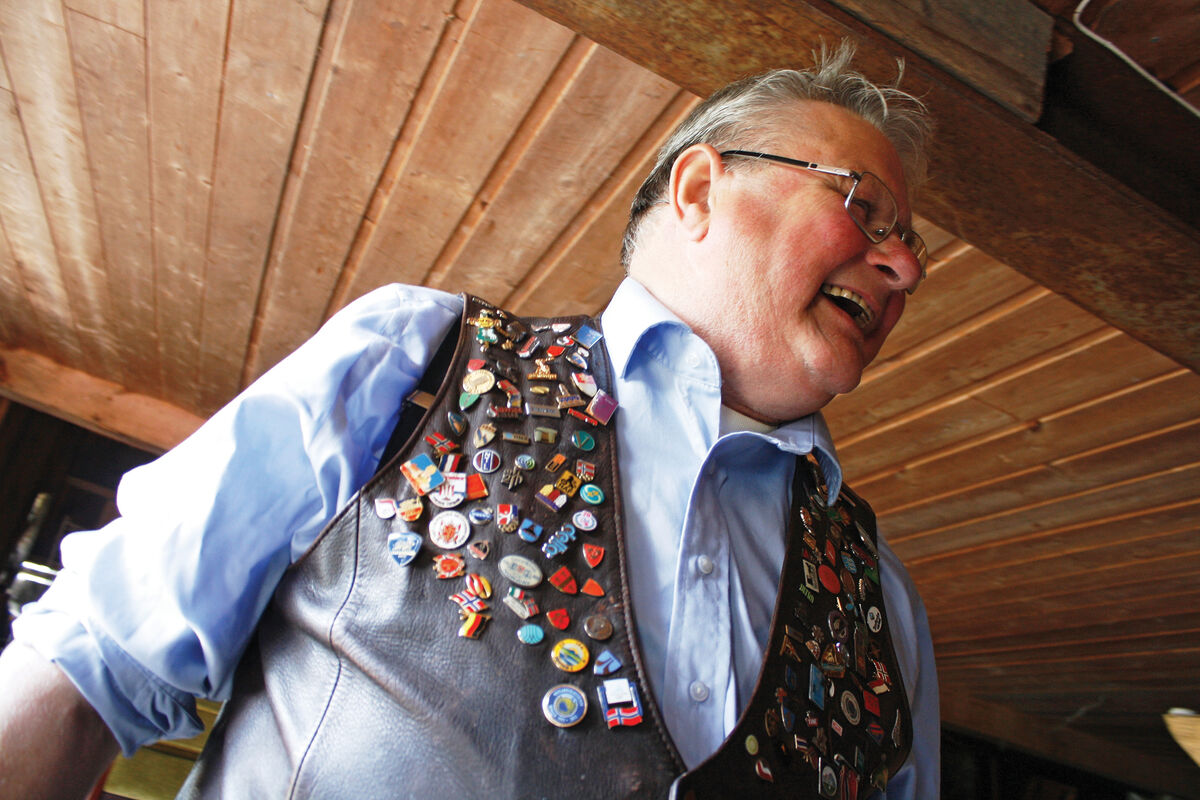
Smalahovetunet host Ivar Løne dons his vest for special occasions —like a visit from The Beer Connoisseur.



